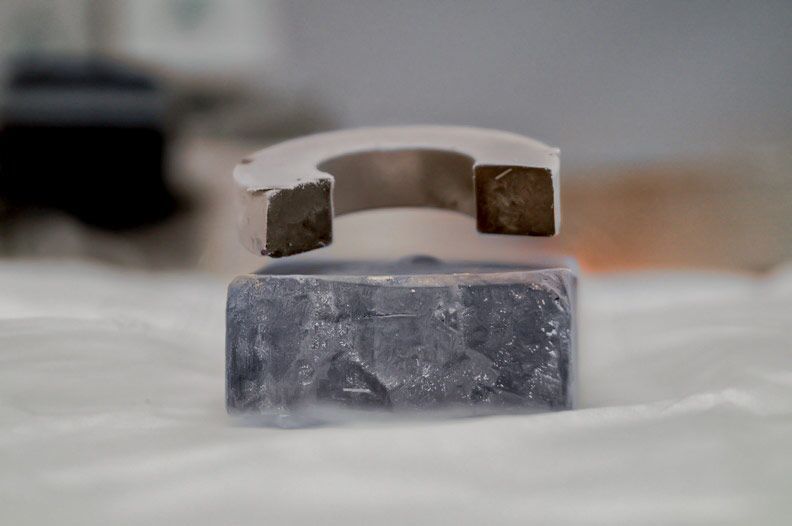
Superconductivity at room temperature: breaching a scientific barrier
Research on room temperature superconducting materials has been one of the biggest challenges of condensed matter physics in the last century. Let’s see how we started and where are we now, after the recent results obtained by researchers at the University at Rochester and published in Nature.
The first discovery, by accident
109 years ago, in 1911, Kammerling Onnes accidentally found, while researching the behaviour of metals in low temperatures, that mercury’s (Hg) electric resistance disappeared at a temperature of 4.2 K. Kammerling Onnes dream was to use these materials to transport electrical energy without energy loss and as a tool to generate powerful magnetic fields. His dreams would have to wait many years, as well as a theoretical explanation of this unexpected phenomenon.
The first complete theory was formulated on 1957, and it was known as the Bardeen – Cooper – Schriefer Theory (BCS). The first powerful magnets were developed in the 60’s, after the discovery of Nb based materials that had extraordinary superconducting properties. The superconductor industry was consolidated once these magnets allowed the creation of magnetic resonance machines and other scientific equipment (like accelerators or measurement tools). The discovery of unique quantic properties like the Josephson effect would allow superconductors to become the most sensitive devices ever created.
High-temperature superconductors and metal hydrides appear on stage
75 years after the discovery of superconductivity (1986), a sudden finding revolutionized the field: high temperature superconductors (cuprates) created a new perspective. For the first time, it was possible to achieve superconducting properties at temperatures above liquid nitrogen (77 K), and after intensive research, it became possible to get superconductivity at 165 K. Conceptually, the dream of having superconductivity at room temperature was no longer a chimera. Eminent theoretical physicist Prof. Neil Ashcroft suggested that the lightest element on the periodic table, hydrogen, could become a room temperature superconductor. However, at standard pressures, hydrogen is a gas, and thus very high pressure was required to turn it into a solid.
The struggle to achieve such pressures promoted the research of metal hydrides in which the heaviest atoms exercise pressure on hydrogen atoms. Numerical simulation was a key technology in the research of the perfect material. The first success of this strategy appeared on 2015, when a team from the Max Planck Institute for Chemistry (Germany) found superconductivity in H3S compounds confined in a diamond cell, a tool that allows extraordinary pressure levels (millions of atmospheres). This binary compound achieved superconductivity at 203 K. One step closer to room temperature.
Superconductivity at room temperature… what’s the catch?
This time around, a team from the University of Rochester (USA) has achieved something that seemed impossible just a hundred years ago: room temperature superconductivity. This group has prepared an in-situ ternary H-S-C compound, introducing C and S poles in the diamond cell, and then injecting it with hydrogen, creating a hydrogen sulfur and methane, in gas form. Heating these gases with a laser creates crystals with a structure that is still unknown, but that has been measured and shows electric and magnetic properties that allow for superconductivity at 287 K (or 14 ºC). Superconductivity in a very light winter: we made it to the top!
We achieved superconductivity at room temperature, but, unfortunately, not at room pressure. These compounds require a pressure of 2,67 million atmospheres, which is 75 % of the pressure at the core of the Earth.
One challenge has been faced, another one is yet to be resolved: can we achieve superconductivity in room temperature and room pressure? It appears that conventional BCS theory explains the superconductivity of these metal hydrides, unlike other high-temperature superconductors (cuprates) that require a new theoretical frame to explain them. In any case, this new finding opens up our knowledge of this quantic phenomenon, even if we are still far away from turning this discovery into its amazing potential applications.
K. Onnes dream is a reality… or not?
The research in cuprates of the last 30 years has turned a physical phenomenon into a useful material that can turn K. Onnes dreams into a reality: allowing for a high density of electrical current through a cable and the generation of intense magnetic fields. Superconducting cuprates are currently being fabricated at the industrial scale and are being used to transport extraordinary currents, 100 times bigger than Cu, under magnetic fields a million times stronger than Earth’s. These properties qualify them for applications under extreme conditions, like big accelerators, fusion, or the creation of intense magnetic fields. Why are we not using these materials in our day-to-day life? What makes us think that discovering room temperature and room pressure superconductors will allow us to completely transform our energy system?
The first question is easy to answer: processing these materials is still too expensive, and the fact that they have to be cooled down with liquid nitrogen makes it even harder to use. We have to develop new production methods that bring costs down and make them more efficient in order to make them more competitive against other technologies that are less efficient but are more consolidated. The second question is tougher to answer, in fact, there is no answer yet. If the laws that govern the new materials we develop are similar to the ones we know at the moment, we will probably be able to have superconductors in proper conditions, but they will not be useful to transfer large amounts of electrical current. We need to find new superconducting materials that operate under new superconducting mechanisms.
A milestone has been reached: room temperature superconductivity. We still have a complex and unknown road ahead, but human ingenuity and persistence will move ahead and bring down the barriers we face. Our hope and eagerness for knowledge are unstoppable.
Xavier Obradors and Teresa Puig
Reference
Room-temperature superconductivity in a carbonaceous sulfur hydride
Elliot Snider, Nathan Dasenbrock-Gammon, Raymond McBride, Mathew Debessai, Hiranya Vindana, Kevin Vencatasamy, Keith V. Lawler, Ashkan Salamat & Ranga P. Dias
Nature 586, 373–377 (2020) Published: 14 October 2020
DOI: 10.1038/s41586-020-2801-z
News: First room-temperature superconductor excites — and baffles — scientists
David Castelvecchi
Nature 586, 349 (2020) Published: 14 October 2020
DOI: 10.1038/d41586-020-02895-0

